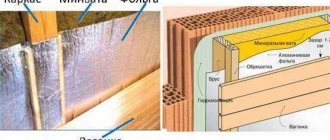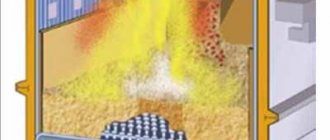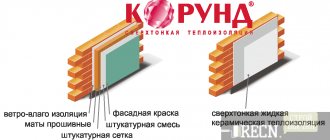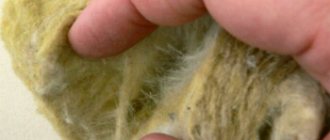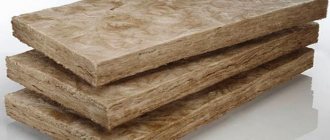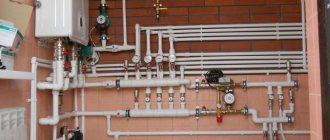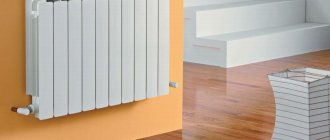Features of heat-resistant sealants
A sealant is a special compound that can create a strong insulating layer on the surface to be treated or between parts. Thermal sealant is the most reliable means, and the requirements for it are very serious. The material is made on the basis of heat-resistant silicone - a polymer that is a transparent elastic mass. Also, other substances are introduced into the composition that enhance the operational properties of the sealant (minerals, metal powder, and others). There are also high temperature epoxy adhesives - two-component products that are mixed before application.
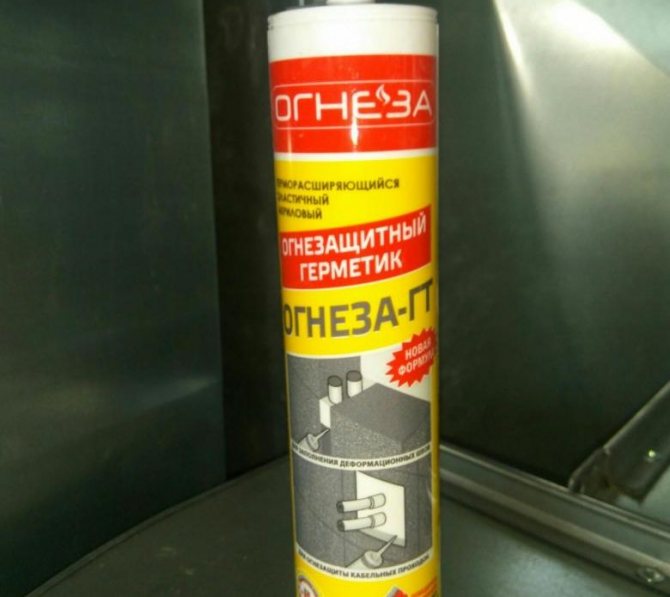
Applications of sealants
The materials are widely used in everyday life and industry. Sealants are involved in the installation of heating pipes, pipelines for supplying cold and hot water, because they can withstand not only heating, but also temperature drops up to subzero temperatures. Heat-resistant sealants are suitable for stoves, chimneys in baths, saunas, private houses. A special automotive compound is useful in strengthening and sealing gaskets, engine seams, headlights, a car muffler, and an exhaust pipe.
With the help of sealants, you can repair heating household appliances - a kettle, hob, oven and even a moonshine still. Typically, a food thermosealant is used for this purpose, which is harmless in contact with food, taking into account heating. The same type of material is used in the repair of equipment in food production, factories, and catering establishments.
Other areas of use of sealants:
- protection of stainless steel products, alloys from moisture penetration;
- prevention of damage to complex equipment operating in air, aggressive conditions;
- restoration of electrical engineering, radio electronics for filling elements and electrical insulation;
- protection of auto parts from corrosion;
- sealing welded seams of gas boilers;
- repair of fireplaces, ventilation, fire structures.
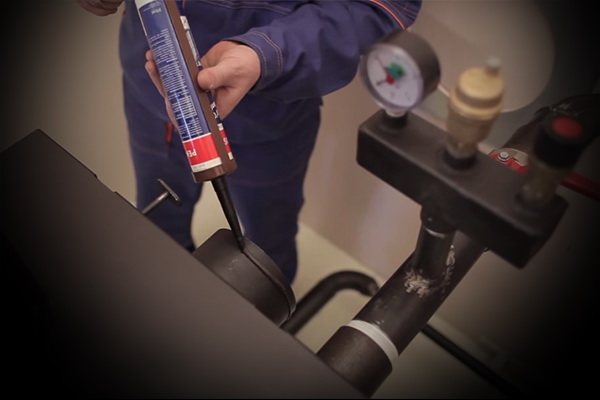

The main properties of sealants
Silicone sealant is a heat-resistant material, the ability to withstand high temperatures is its hallmark. Conventional heat-resistant sealants are used up to +350 degrees, but there are compositions that can withstand +1500 degrees, therefore they are considered refractory. The materials are non-flammable, non-flammable, non-explosive.
Other properties of sealants:
- the ability to withstand high loads without loss of sealing properties;
- plasticity and elasticity (due to this, the seam does not crack after drying);
- good adhesion to any materials (provided the surface is dry at the time of application);
- moisture resistance;
- long working life and long storage period;
- non-toxic, safety for humans, the environment and animals.
Almost any sealant is oil-resistant or oil-resistant - it does not deteriorate from contact with refined products. Also, most products are immune to the action of weak acids, alkalis, other chemicals and household chemicals.
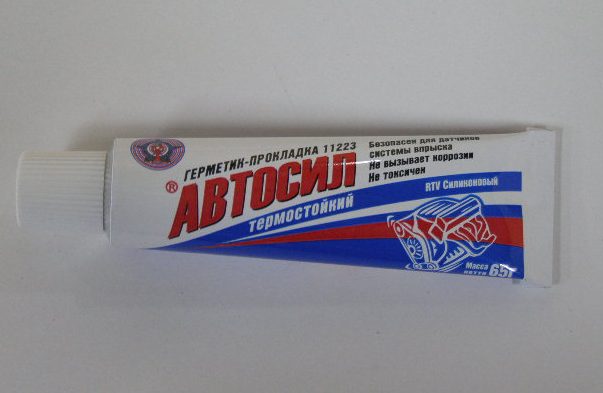

The negative properties of sealants include the fact that they do not adhere well to wet surfaces, the level of adhesion drops dramatically. Also, before use, you should treat the base from small debris, otherwise the seam will not serve for a long time. Some products do not harden quickly, and it will take several days before use. The sealant cannot be painted, the paint does not stick to it, although there are colored products on sale (red, black, etc.).Too large gaps are not recommended to be sealed with a thermo-sealant, since the material may not harden in depth.
Additional features of sealants
Thermal sealants also have a number of related properties, which are sometimes no less in demand. So, most of them are resistant to UV radiation, therefore they are suitable for outdoor work, for example, for gluing a defect in a chimney, roofing passages. The sealants are frost-resistant, which makes them indispensable for the repair of baths, stoves and fireplaces in country houses, which are not heated all year round. After application, the compositions do not crack during vibration, so they are used for the restoration of machinery and equipment.
Modern materials for sealing heating units
Fireplace and stove sealant is a polymer material similar in structure to a paste. It can be one-component or two-component. One-component adhesive sealant is usually packaged in tubes for an assembly gun, this is the most convenient option for work. The two-component material is used only by professionals, since errors are not allowed when mixing the composition - you need skill to properly prepare the working material.
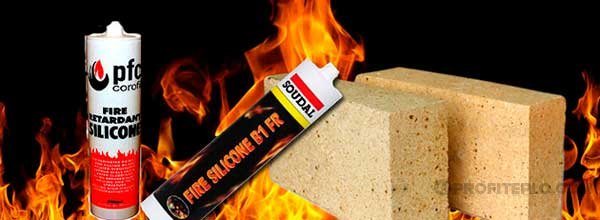

High Temperature Oven Sealant
For the installation and repair of stoves, fireplaces and heating boilers, special high-temperature compositions are used, according to the scope and material of manufacture, they are divided into two types:
- Heat resistant sealants. Designed for areas where heating does not exceed 350 ° C. Suitable for sealing cracks and joints in the outer masonry of stoves and fireplaces (but not in places of contact with molding!), For sealing chimneys made of bricks and sandwich pipes. For a single metal chimney, a heat-resistant composition is allowed to be used only if it is a chimney of a pyrolysis or condensing boiler - in this case, the temperature of the exhaust gases does not exceed 150 ° C.
- Heat-resistant and fire-resistant sealants. The high-temperature sealant is designed for use inside the combustion chamber, at the points of contact between the masonry and the casting. It is used to seal any chimneys, including for the joint with the outlet of the furnace. Flame retardant sealant is a type of heat resistant sealant that can withstand direct contact with a flame. Not all heat-resistant compounds are fire-resistant (fireproof), when buying, pay attention to the labels on the packaging.
It is necessary to choose an assembly and repair composition for boilers and furnaces taking into account the temperature regime of the zone where they will be used. By composition, sealants are divided into silicone and silicate.
Thermosealant is a silicone-based material. Due to the introduction of iron oxide into the composition, the material has a reddish-brown tint. Manufacturers offer silicone sealants with different temperature thresholds, specific data are indicated on the packaging.
The neutral heat-resistant silicone sealant is compatible with all materials and dries to release alcohols and water.


High temperature silicone sealant
Its advantages include:
- resistance to UV radiation - the material is suitable for sealing cracks on the outer part of the chimney, joints of roof penetrations;
- hydrophobicity - due to its waterproofness, it is used to seal the joints of penetrations to the waterproofing of the roof;
- high adhesion with materials of different structure, including brick, cement, metal;
- preservation of elasticity after drying - the tightness of the connection will not be disturbed by small vibrations.
Main types of high temperature sealants
There are different types of sealants on the market that have the ability to withstand high temperatures. For repairing defects in the oven masonry, it is better to buy those that contain silicates and silicone. The products are packaged in small cylindrical cartridges, which can be conveniently inserted into the assembly (glue) gun.
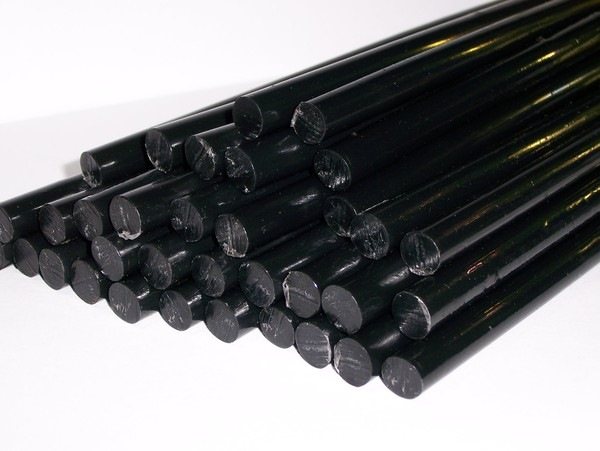

Also on sale you can find small packages in tubes resembling a paste, which are used like any ordinary glue. Various colors allow you to choose the composition to match the color of the base material to make the patch aesthetically pleasing or even visually invisible. All sealants are divided into heat-resistant, heat-resistant, sealing and facing properties.
Heat resistant sealants
The basis of such funds is silicone, they can withstand up to +350 degrees. To achieve such resistance to heating, iron oxide is also added to the composition, therefore, the main color of the mass becomes orange. Some products contain acetic acid, they are absolutely not suitable for iron - creating an oxide film, sealants will not provide sufficient adhesion. But for aluminum, other non-ferrous metals and stainless steel, they can be used, although for any metal it is better to purchase an acid-free composition.
Typically, heat-resistant sealants are used to apply to the outer walls of fireplaces and stoves. They are also suitable for open areas where the seam will be affected by atmospheric factors, ultraviolet light - for example, for roofing from corrugated board, tiles. You can use compounds to eliminate gaps in the chimney or car parts. The thermal resistance limit is always indicated on the packaging. It must be remembered that +350 degrees is the upper limit of a short-term temperature rise. Constant heating should not exceed + 250 ... + 270 degrees.
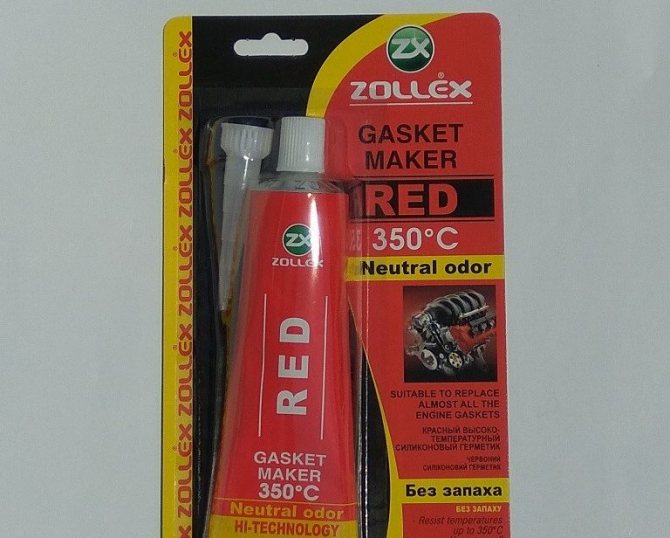

Polymerization of the sealant occurs in a few hours, some heat-resistant agents harden only after 1-2 days. The closer the expiration date, the faster this process takes place. The ideal conditions for the polymerization of the sealant are considered to be + 23 ... + 25 degrees, humidity 50%. Other conditions will slow down or speed up the complete curing of the material.
Heat resistant sealants
Such products contain silicates, therefore they are designed for more serious heating - up to +1500 degrees, and even direct exposure to flame is possible. Heat-resistant sealants should be repaired between the bricks, cast-iron elements of the furnace masonry, the seams of the combustion chamber, defects in heating boilers. Sealants do not lose their properties even under extreme heating, but when exposed to open fire, you need to find in the instructions a direct indication from the manufacturer of this possibility.
Heat-resistant sealants are usually black, gray due to the presence of silicates. They adhere perfectly to any materials, and yet it is recommended to sand the surface before applying. The work should be carried out at a temperature close to +20 degrees. After drying, the seam will be tough, since such sealants are not highly elastic. It is better not to use them on products subject to vibration, but they are great for structures that have already undergone shrinkage.
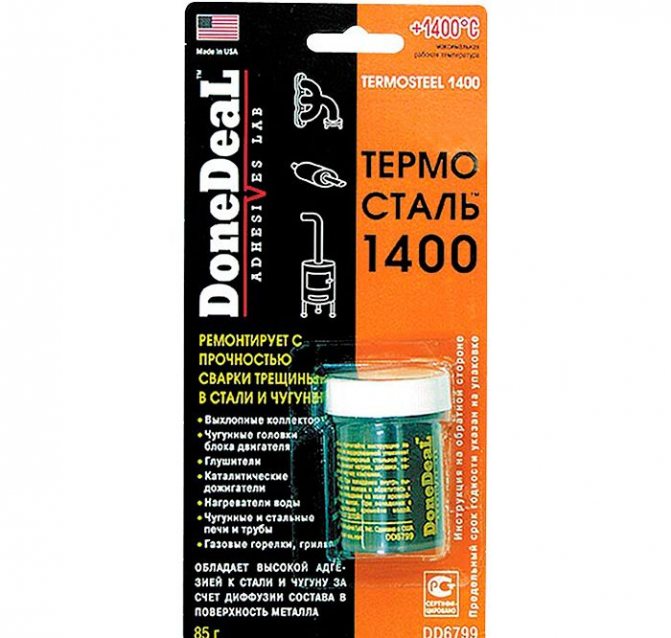

Silicone seals
You can also find a red or blue semi-liquid silicone paste on sale. As it hardens, it forms an elastic seam that can stretch up to 2 times. Such sealants are used for new masonry, which are subject to strong shrinkage. It is also possible to use seals to cover sandwich chimneys from the outside. Means cannot withstand high heating - they work only within the range of -40 ... + 250 degrees. The maximum seam depth should not be more than 6 mm, application is carried out at + 5 ... + 30 degrees. The most popular brands of silicone seals are Titanium, Moment-Herment, Penosil.
Adhesive facing compounds
Materials with adhesive properties are used if the oven masonry is covered with a network of cracks, because it is unrealistic to process the entire area with an ordinary sealant. Facing compounds perfectly penetrate the narrowest and deepest cracks, reliably hiding them. After repairing the fireplace, the stove will acquire a more aesthetic appearance.Typically, such mixtures are sold in buckets ready-made or in bags in the form of a dry powder. The heat resistance of the facing compounds can be different:
- mixtures based on kaolin dust, chamotte - up to +400 degrees;
- one-component adhesives with mineral additives - up to +800 degrees;
- mastics for gluing tiles, stone - up to +1000 degrees.
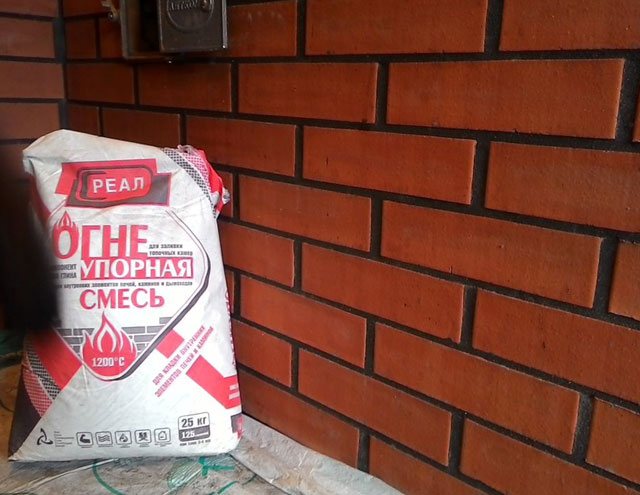

Carrying out work and the sequence of their implementation ↑
The application of a heat-resistant sealant is carried out on a base previously prepared and free from dust and dirt - for this, a special cleaner is used that is suitable for a specific material, or white spirit. When working with fireplace masonry, you should also take care of cleaning the walls from soot and soot.
Please note: silicone group sealants are applied to a dry substrate. As for silicate mixtures, before applying the heat-resistant sealant, the material is slightly moistened to improve adhesion.
Before starting work, cut off the tip of the tube at an angle of approximately 45 degrees. A special assembly gun is used for application - with its help, the seam is more uniform and aesthetic. The tube is placed inside so that the piston device is on one side and the tip is on the other.
To adjust the applied layer, use a spatula or a regular knife - you just need to slightly moisten the tool with water first. The work is carried out on condition that the temperature around is not lower than +5 degrees, while the optimal temperature regime is +20. It is imperative to have gloves; if it comes into contact with the skin, immediately rinse the contaminated area under a copious stream of water.
The exact width of the applied layer is indicated on the tube - you should carefully read the manufacturer's recommendations before starting work. As a rule, the width does not exceed 3 cm. If the layer is wider, there is a high probability of its quick cracking, which will entail disruption of the functioning of the chimney section, or even the entire system.
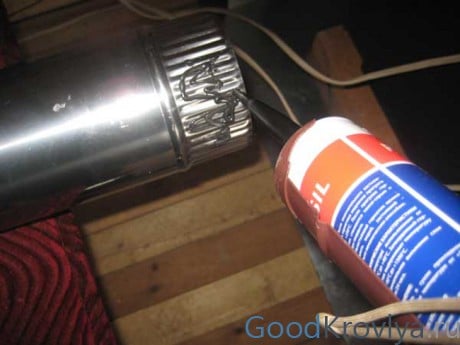

Applying sealant to the base
Heat-resistant silicone sealant is not recommended for sealing deep cracks - the material requires moisture from the air to harden, so if there is a deep seam, the internal mass may simply not harden. As for the speed of solidification, it largely depends on the surrounding conditions - the warmer, the faster the process goes.
Upon completion of the work, check the tightness of the joints and joints obtained. It is very simple to do this - the stove is fired up, while covering the roofing chimney outlet. If the connection is of good quality, there will be no smoke, otherwise additional sealing is required.
Working with sealant
For the convenience and speed of applying the product, it is worth immediately preparing the necessary tools. This is an assembly gun (if the sealant is implemented in the form of a cylindrical balloon), a gas burner, a rubber spatula, a stationery knife, paper tape, gloves. A gas burner is only required when using heat-resistant sealants.
Metal application process
To begin with, any surface should be carefully prepared. It is treated with sandpaper, another abrasive material to remove rust, polyurethane foam and improve the quality of adhesion. Next, the base must be rinsed and degreased with alcohol, dried completely. All adjacent areas are covered with masking tape.
Before work, you must put on gloves and load the pistol. The upper part of the tube is cut off, then a cap is put on it. The cartridge is inserted into the gun and the sealant application begins. The procedure is as follows:
- squeeze the product into the place of the defect;
- the thickness of the seam cannot be made larger than indicated in the instructions;
- the applied mass must completely cover the crack;
- immediately after squeezing out, smooth the sealant with a spatula, you can also remove the excess composition before hardening (it will be problematic to do this as it cures);
- heat-resistant agents dry under normal conditions, heat-resistant ones are dried in stages, with heating;
- you should wait until the full hardness of the composition is reached, after which you can start operating the part.
Working with thermo-sealant for stoves and fireplaces
The sealing of the gaps between the bricks is carried out especially carefully in order to achieve high quality and maintain an aesthetic appearance. The surface of the brick can be covered with masking tape so as not to stain, leaving only cracks or seams open. The nose of the tube is cut so that the hole is beveled, and its diameter becomes less than the width of the seams. After installing the tube in the pistol, you can start working:
- clean the surface of dirt, sandpaper, which will help enhance adhesion;
- degrease the base, dry it with a construction hair dryer;
- glue masking tape;
- fill the gaps with sealant, leave to dry for a day;
- burn the heat-resistant sealant with the flame of a gas burner, after which it will acquire its properties.
Immediately after completion of the work, the oven must not be ignited at full power. It is heated gradually so that the sealant does not crack.
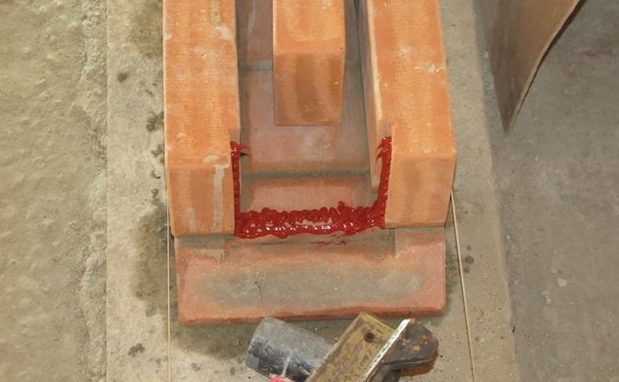

Substrate preparation before sealing
The preparation technology depends on the type of substrate and composition.
- When destroyed, the brick exfoliates and crumbles. If you just cover it over, most likely, over time, a whole fragment will disappear. Therefore, you first need to clean up everything.
- Metal has poor adhesion. The surface must be cleaned of microscopic dust. Even little things like that will impair grip. It is recommended to degrease the base with a special solvent or white spirit.
Use masking tape to avoid staining adjacent areas. Observe the thickness recommended by the manufacturer. Too thick will not harden, and thin will crack when used.
It is recommended to wait a longer curing time before re-using the fireplace or stove. If it is 24 hours, it is better to wait at least 2-3 days.
To harden the sealant, you can gradually warm up the heater. Just not too intensely and under strict control. The stages of the polymerization process can be easily controlled by the color of the mass.
Heat resistant car sealants
Motorists often notice noise, knocking and other muffler defects. They occur if there are gaps between the elements. Or if incompatible parts from different manufacturers were used. It is impossible to be completely insured against such a problem.
And heat-resistant high-temperature sealants for cars will help to solve it. It is enough to treat the problem area with paste. With its help, you can temporarily eliminate cracks and mechanical damage. But it is better to use special cement or replace the part.
There are other automotive sealants available: for the engine, for repairing leaks, and even for repairing tires.
Anaerobic heat resistant sealants
It is more convenient to use anaerobic compounds to connect spare parts. This is a modern solution that features curing technology. Silicone hardens from moisture, and anaerobic mass - in the absence of oxygen.
This means that it can be applied and distributed among the elements. It will remain liquid until the parts are firmly pressed together. But it is better not to delay the process, because even fine dust impairs adhesion.
Please note that anaerobic sealants are pressure sensitive and that the maximum thickness of gaps that can be filled is 0.5 mm. It must be applied as evenly as possible, otherwise the part will remain liquid.
Top manufacturers
It is better to buy products from trusted manufacturers - their quality is usually higher. The low price should be alarming - heat-resistant products cannot be too cheap.Otherwise, organic substances may be added to them to reduce the amount of silicone. The strength of such a material will be much lower, as well as the elasticity.
The following brands have proven themselves well:
- Moment Herment High Temperature. Withstands up to +315 degrees, can be used for car repairs, heating systems, perfectly fills grooves and cracks, is suitable for metal, wood, stone, glass, plastic.
- ABRO. Sealants of this company are sold in a large assortment, of different colors, with different technical characteristics. Within seconds, the products create gaskets with the highest strength.
- Penosil. The Estonian brand produces a material for filling seams, cracks, which can withstand up to +1500 degrees of heating.
- Macroflex. Refractory sealants of this brand are used for joining parts and repairing defects on products with low mobility, since the connection will be rigid. Withstand temperatures of + 1200 ... + 1500 degrees.
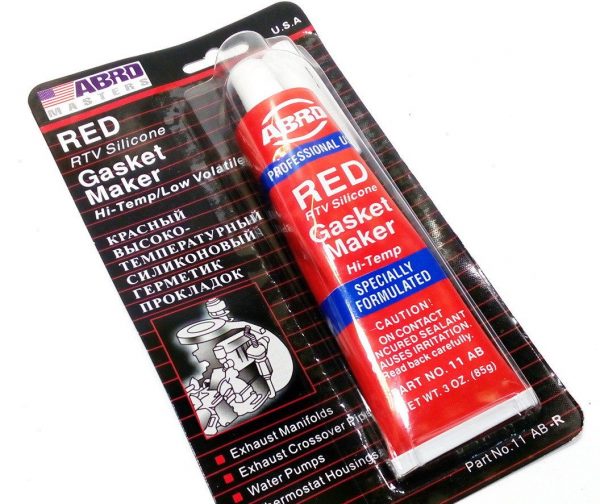

Soudal, Krass, Titan sealants are also famous for their excellent quality. All these tools can eliminate the need for expensive repairs or rearrangement of stoves and fireplaces. With strict adherence to the instructions, you can get a reliable connection by doing all the work yourself.
Popular brands
There are sealing materials on the market for stoves, fireplaces and chimneys. They are chosen according to their composition and temperature regime of operation. It is recommended to use products from reputable manufacturers.
Soudal
Soudal (Saudal) - a Belgian company that specializes in the manufacture of sealing compounds. Soudal stove and fireplace sealant is the Soudal series.
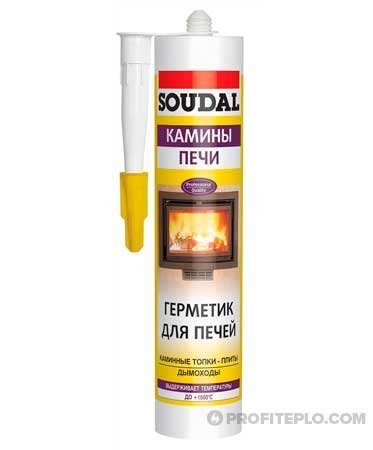

Soudal oven sealant
Calofer, refractory compounds in black. Materials based on sodium silicate do not emit toxic substances when heated, they can be colored. Suitable for sealing cast iron elements of boiler units. One of the advantages of Belgian products is their resistance to cracking and crumbling.
We offer you to familiarize yourself with: Bath made of scraps of boards
Penosil
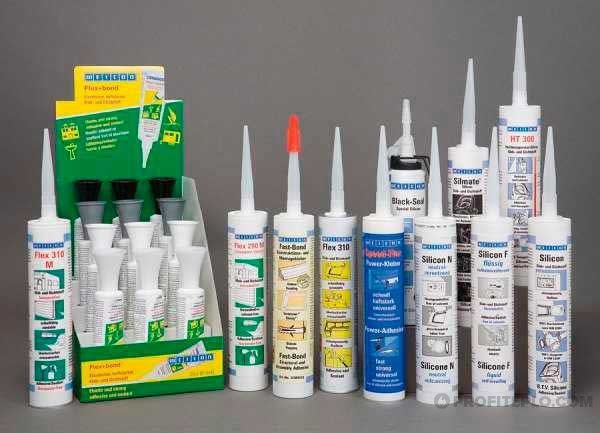

An Estonian company produces silicate paste for ovens Penosil 1500. The material is highly heat-resistant and has a black color. Penosil is cheaper than the products of the famous Belgian manufacturer, but not inferior to him in quality. This makes the Estonian sealant widely sought after by professionals and DIYers.
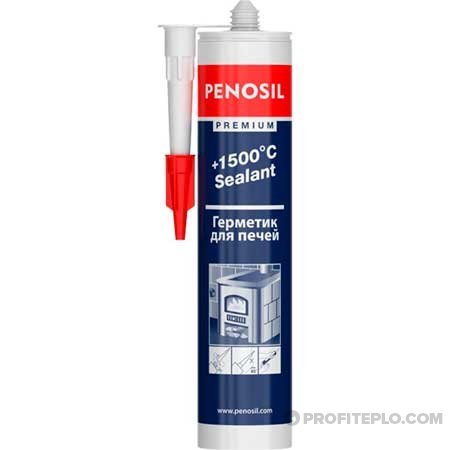

Penosil Premium Oven Sealant
Under this brand, sealants are produced by the Selena Group - a group of Polish manufacturers of professional materials for construction and decoration. The composition of the sealing paste includes fiberglass, which provides the sealed joints with increased gas tightness. The material is designed for heating to high temperatures (1250 degrees), which makes it suitable for sealing joints and cracks in fireplace and stove masonry, for installing chimneys.


Silicate fireplace sealant Tytan
Makroflex
A well-known Estonian manufacturer of sealing materials supplies the market with refractory silicate composition Makroflex HA147. It can withstand short-term heating up to a high temperature of 1500 degrees and exposure to an open flame. The advantages of the paste of their inorganic materials include adhesion to most materials used in construction, and the absence of shrinkage during drying and under the influence of temperature fluctuations.
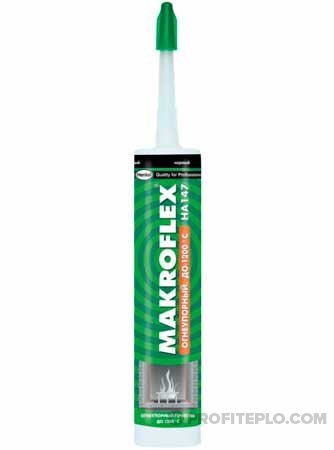

Refractory silicate sealant Makroflex
The Russian manufacturer offers refractory composition "Krass fireplaces and stoves". Using this material, fireclay masonry can be mounted in the furnace firebox, fire retardant masonry. The composition withstands a sharp increase in temperature, is not afraid of open fire, is suitable for repairing brick stoves and fireplaces, as well as heating boilers. It is a non-shrinking material made on the basis of liquid glass.Easy to apply due to its pasty consistency.
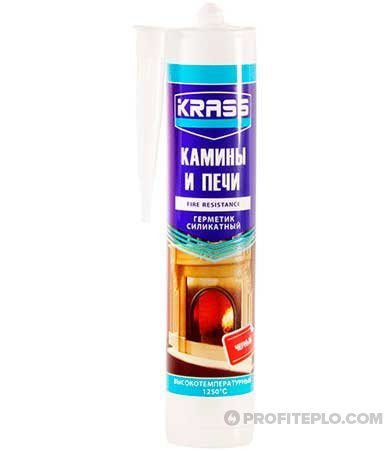

High-temperature silicate sealant Krass
HEAT RESISTANT SEALANT PENOSIL 1500 C
Sealants of this brand can withstand temperatures up to 1250 ° C. In addition, due to the presence of a fiberglass mixture in the composition, they have excellent smoke and gas resistance, as a result of which they are in high demand from professionals.
Soudal C... This is a Belgian company that produces a wide range of sealing materials, including high temperature ones (for example, Soudal Calofer, Fix All, etc.).
High-temperature sealants are indispensable for arranging chimney structures for stoves or fireplaces. They have many important advantages, but at the same time there are many features, and therefore, before buying a specific material, you should carefully familiarize yourself with its characteristics and the recommendations of specialists. This will avoid miscalculations and mistakes and make the best choice in which the tightness of the chimney structure will be ensured in the best possible way.
What to look for when looking for a sealant
When choosing a sealant, the following points should be considered:
- Operating conditions of the heating device;
- The location of the joint or seam (inside the pipe, outside the chimney or on the roof);
- Temperature regime of the treated surface: Heat-resistant agents are mainly used to seal chimneys
- Consistency and composition of the sealant: solid silicone is best used for cracks in masonry;
- Material for the manufacture of chimney elements.
A properly selected hermetic means will save you from unforeseen expenses for cleaning or disassembling the chimney installation.
Tags: sealant, chimney, heat-resistant
«Previous post
Requirements for heat-resistant sealants
To meet the operating conditions, furnace repair compounds must have the following characteristics:
- heat resistance is a determining factor that determines the preservation of characteristics when exposed to high temperatures;
- safety - the absence of harmful emissions into the environment of the room;
- high degree of adhesion;
- strength after curing.
Important! Failure to meet one of the listed requirements makes the repair material unsuitable for its intended use.
Refractory sealant manufacturers
There are a lot of different manufacturers of high-temperature sealants on the repair and construction market, of which the following are the most popular in the domestic market:
Penosil... This company manufactures both heat-resistant and heat-resistant sealing products. The heat-resistant material is a red silicone acid paste that is resistant to temperatures up to 300 ° C. In contrast, the heat-resistant version, labeled Penosil-1500, is a black material with a maximum operating temperature of 1500 ° C.
Tytan... The Polish company Selena Group produces its heat-resistant products under this brand.





